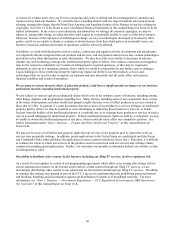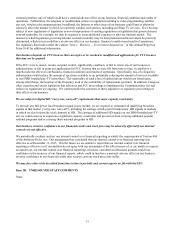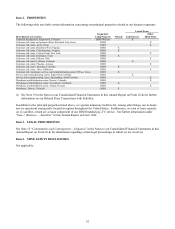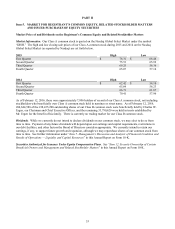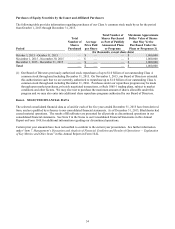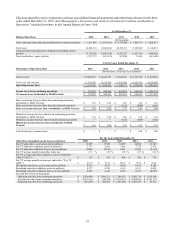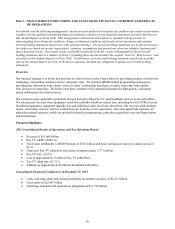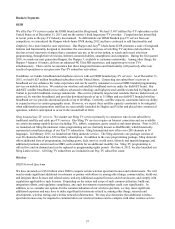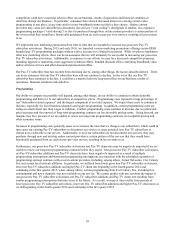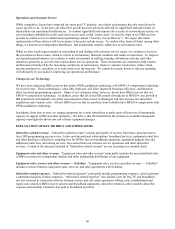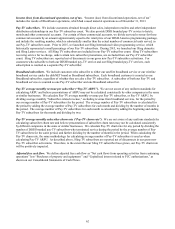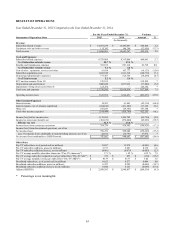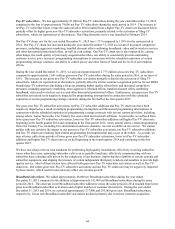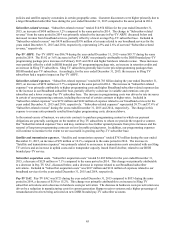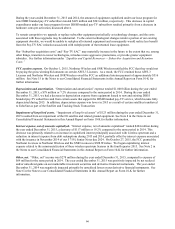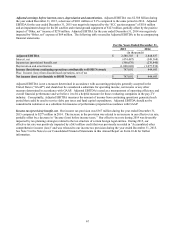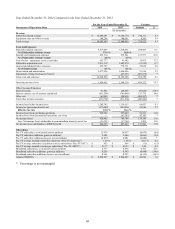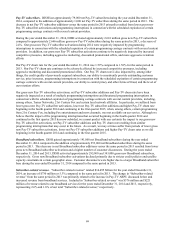Dish Network 2015 Annual Report Download - page 69
Download and view the complete annual report
Please find page 69 of the 2015 Dish Network annual report below. You can navigate through the pages in the report by either clicking on the pages listed below, or by using the keyword search tool below to find specific information within the annual report.59
competition could have a material adverse effect on our business, results of operations and financial condition or
otherwise disrupt our business. In particular, consumers have shown increased interest in viewing certain video
programming in any place, at any time and/or on any broadband-connected device they choose. Online content
providers may cause our subscribers to disconnect our services (“cord cutting”), downgrade to smaller, less expensive
programming packages (“cord shaving”) or elect to purchase through these online content providers a certain portion of
the services that they would have historically purchased from us, such as pay per view movies, resulting in less revenue
to us.
We implement new marketing promotions from time to time that are intended to increase our gross new Pay-TV
subscriber activations. During 2015 and early 2016, we launched various marketing promotions offering certain DISH
branded pay-TV programming packages without a price increase for a limited time period. While we plan to implement
other new marketing efforts, there can be no assurance that we will ultimately be successful in increasing our gross new
Pay-TV subscriber activations. Additionally, in response to our efforts, we may face increased competitive pressures,
including aggressive marketing, more aggressive retention efforts, bundled discount offers combining broadband, video
and/or wireless services and other discounted promotional offers.
Our Pay-TV subscriber base has recently been declining due to, among other things, the factors described above. There
can be no assurance that our Pay-TV subscriber base will not continue to decline. In the event that our Pay-TV
subscriber base continues to decline, it could have a material adverse long-term effect on our business, results of
operations, financial condition and cash flow.
Programming
Our ability to compete successfully will depend, among other things, on our ability to continue to obtain desirable
programming and deliver it to our subscribers at competitive prices. Programming costs represent a large percentage of
our “Subscriber-related expenses” and the largest component of our total expense. We expect these costs to continue to
increase, especially for local broadcast channels and sports programming. In addition, certain programming costs are
rising at a much faster rate than wages or inflation. Further, programming costs continue to increase due to contractual
price increases and the renewal of long-term programming contracts on less favorable pricing terms. Going forward, our
margins may face pressure if we are unable to renew our long-term programming contracts on acceptable pricing and
other economic terms.
Increases in programming costs generally cause us to increase the rates that we charge to our subscribers, which could in
turn cause our existing Pay-TV subscribers to disconnect our service or cause potential new Pay-TV subscribers to
choose not to subscribe to our service. Additionally, even if our subscribers do not disconnect our services, they may
purchase through new and existing online content providers a certain portion of the services that they would have
historically purchased from us, such as pay-per-view movies, resulting in less revenue to us.
Furthermore, our gross new Pay-TV subscriber activations and Pay-TV churn rate may be negatively impacted if we are
unable to renew our long-term programming contracts before they expire. Our gross new Pay-TV subscriber activations,
net Pay-TV subscriber additions and Pay-TV churn rate have been negatively impacted as a result of multiple
programming interruptions and threatened programming interruptions in connection with the scheduled expiration of
programming carriage contracts with several content providers, including, among others, Turner Networks, 21st Century
Fox and certain local network affiliates. In particular, we suffered from lower gross new Pay-TV subscriber activations,
lower net Pay-TV subscriber additions and higher Pay-TV churn rate beginning in the fourth quarter 2014 and
continuing in the first quarter 2015, when, among others, certain programming from 21st Century Fox, including Fox
entertainment and news channels, was not available on our service. We cannot predict with any certainty the impact to
our gross new Pay-TV subscriber activations, net Pay-TV subscriber additions and Pay-TV churn rate resulting from
similar programming interruptions that may occur in the future. As a result, we may at times suffer from periods of
lower gross new Pay-TV subscriber activations, lower net Pay-TV subscriber additions and higher Pay-TV churn rates as
we did beginning in the fourth quarter 2014 and continuing in the first quarter 2015.


